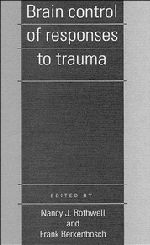Book contents
- Frontmatter
- Contents
- Contributors
- 1 Introduction
- 2 Responses to injury
- 3 Experimental approaches to the central nervous system control of responses to trauma
- 4 Neurohormonal control of cytokines during injury
- 5 Brain regions involved in modulation of immune responses
- 6 Psychological and neurobiological consequences of trauma
- 7 Central nervous system control of sickness behavior
- 8 Psychological and behavioural aspects of pain
- 9 Central control of cardiovascular responses to injury
- 10 Neuroendocrine responses to physical trauma
- 11 Central control of metabolic and thermoregulatory responses to injury
- 12 Central control of pain
- 13 The final word …
- Index
1 - Introduction
Published online by Cambridge University Press: 05 August 2016
- Frontmatter
- Contents
- Contributors
- 1 Introduction
- 2 Responses to injury
- 3 Experimental approaches to the central nervous system control of responses to trauma
- 4 Neurohormonal control of cytokines during injury
- 5 Brain regions involved in modulation of immune responses
- 6 Psychological and neurobiological consequences of trauma
- 7 Central nervous system control of sickness behavior
- 8 Psychological and behavioural aspects of pain
- 9 Central control of cardiovascular responses to injury
- 10 Neuroendocrine responses to physical trauma
- 11 Central control of metabolic and thermoregulatory responses to injury
- 12 Central control of pain
- 13 The final word …
- Index
Summary
It is obvious to most biologists and clinicians that in mammals the central nervous system coordinates and regulates many complex physiological events. In order to do this, it must receive information from the internal and external environment, integrate this information and elicit appropriate efferent signals required to respond to a stimulus and maintain homeostatic function.
The concept of the brain as a regulator of responses to pathogenic insults is somewhat recent and still poses many unanswered questions. This may have resulted in part from a tendency for studies on injury and inflammation to focus on local tissue factors and immune mediators. It has, of course, long been known that certain aspects of the host defence response, such as fever, are under central nervous system control. However, concepts such as the effects of stress on susceptibility to disease, or the sustained psychological responses following trauma, were only poorly understood and were considered by some to be undefined and unsuitable for rigorous scientific analysis. This situation is changing rapidly, not least because of the identification of molecules and mechanisms underlying direct communications between the brain and the immune system, and the realisation that these are not distinct and unrelated biological entities.
The objectives of this book have been to discuss current knowledge about how the brain responds to and influences host responses to trauma, and to consider the mechanisms of these interactions, the clinical relevance and potential for novel therapeutic interventions. In spite of enormous advances in this field over the past decade, it will be clear that for each question that has been answered, a number of others have been raised. The planning of this book and most of the work in editing was carried out collaboratively with Dr Frank Berkenbosch at the University of Amsterdam. Frank died tragically at the age of only thirty-nine, shortly before completion of this book. With the agreement of all of the contributors, the book has been dedicated to his memory. I believe that this is a fitting tribute, not simply because of his work on many of the subjects covered in this book, or because of his scientific and social interaction with several of the contributors, but also because the very nature of the subject closely reflects Frank's outstanding contribution to scientific research.
- Type
- Chapter
- Information
- Brain Control of Responses to Trauma , pp. 1 - 2Publisher: Cambridge University PressPrint publication year: 1994



